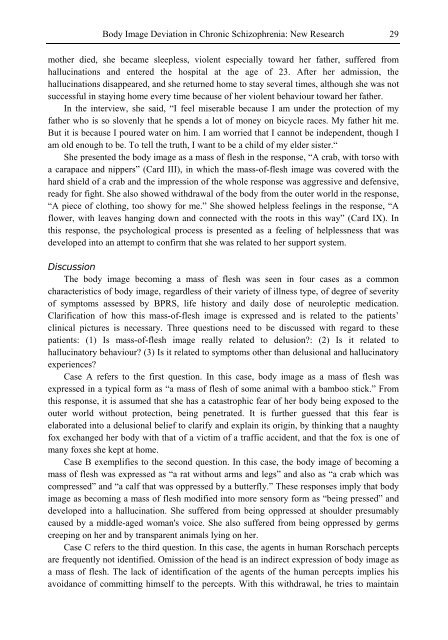Schizophrenia Research Trends
Schizophrenia Research Trends
Schizophrenia Research Trends
- No tags were found...
You also want an ePaper? Increase the reach of your titles
YUMPU automatically turns print PDFs into web optimized ePapers that Google loves.
Body Image Deviation in Chronic <strong>Schizophrenia</strong>: New <strong>Research</strong> 29mother died, she became sleepless, violent especially toward her father, suffered fromhallucinations and entered the hospital at the age of 23. After her admission, thehallucinations disappeared, and she returned home to stay several times, although she was notsuccessful in staying home every time because of her violent behaviour toward her father.In the interview, she said, “I feel miserable because I am under the protection of myfather who is so slovenly that he spends a lot of money on bicycle races. My father hit me.But it is because I poured water on him. I am worried that I cannot be independent, though Iam old enough to be. To tell the truth, I want to be a child of my elder sister.“She presented the body image as a mass of flesh in the response, “A crab, with torso witha carapace and nippers” (Card III), in which the mass-of-flesh image was covered with thehard shield of a crab and the impression of the whole response was aggressive and defensive,ready for fight. She also showed withdrawal of the body from the outer world in the response,“A piece of clothing, too showy for me.” She showed helpless feelings in the response, “Aflower, with leaves hanging down and connected with the roots in this way” (Card IX). Inthis response, the psychological process is presented as a feeling of helplessness that wasdeveloped into an attempt to confirm that she was related to her support system.DiscussionThe body image becoming a mass of flesh was seen in four cases as a commoncharacteristics of body image, regardless of their variety of illness type, of degree of severityof symptoms assessed by BPRS, life history and daily dose of neuroleptic medication.Clarification of how this mass-of-flesh image is expressed and is related to the patients’clinical pictures is necessary. Three questions need to be discussed with regard to thesepatients: (1) Is mass-of-flesh image really related to delusion?: (2) Is it related tohallucinatory behaviour? (3) Is it related to symptoms other than delusional and hallucinatoryexperiences?Case A refers to the first question. In this case, body image as a mass of flesh wasexpressed in a typical form as “a mass of flesh of some animal with a bamboo stick.” Fromthis response, it is assumed that she has a catastrophic fear of her body being exposed to theouter world without protection, being penetrated. It is further guessed that this fear iselaborated into a delusional belief to clarify and explain its origin, by thinking that a naughtyfox exchanged her body with that of a victim of a traffic accident, and that the fox is one ofmany foxes she kept at home.Case B exemplifies to the second question. In this case, the body image of becoming amass of flesh was expressed as “a rat without arms and legs” and also as “a crab which wascompressed” and “a calf that was oppressed by a butterfly.” These responses imply that bodyimage as becoming a mass of flesh modified into more sensory form as “being pressed” anddeveloped into a hallucination. She suffered from being oppressed at shoulder presumablycaused by a middle-aged woman's voice. She also suffered from being oppressed by germscreeping on her and by transparent animals lying on her.Case C refers to the third question. In this case, the agents in human Rorschach perceptsare frequently not identified. Omission of the head is an indirect expression of body image asa mass of flesh. The lack of identification of the agents of the human percepts implies hisavoidance of committing himself to the percepts. With this withdrawal, he tries to maintain
















